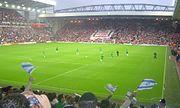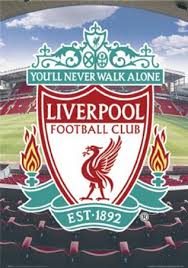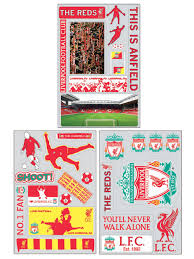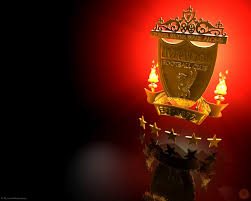
 |  |  |  |  |

English Premier League
England
The Barclays English Premier League (EPL), considered as the best in the world.
Portsmouth FC vs Liverpool FC
Official name Portsmouth FC
City Portsmouth
Founded 1898
Club colors Blue / White / Red
vs.
0 - 0
Liverpool FC
Official name Liverpool FC
City Liverpool
Founded 1892
Club colors Red / Red / Red
Match scheduled:
Date: 19-12-2009
Time: 12:45 until 14:45
Week 18 / Round 18 :: Barclays Premier League 2009/2010

The best known chant sung by Portsmouth supporters is the Pompey Chimes ("Play up Pompey, Pompey play up", sung to the tune of the Westminster Chimes) which is sung around Fratton Park. The origins of the 'Pompey Chimes' lies with the Royal Artillery, Portsmouth's most popular and successful football team for much of the 1890s, who played many of their home games at the United Services ground in Burnaby Road. The nearby Guildhall clock would strike the quarter hours and the referees would use the clock to let them know when the match should finish at 4pm. Just before 4pm the crowd would lilt in unison with the chimes of the hour to encourage the referee to blow the whistle signifying full time. The original words to 'The Chimes', as printed in the 1900-01 Official Handbook of Portsmouth FC, were:
Play up Pompey,
Just one more goal!
Make tracks! What ho!
Hallo! Hallo!!
With the demise of Royal Artillery after their expulsion from the 1898-99 FA Amateur Cup for alleged professionalism, many of Royal Artillery's supporters transferred their allegiance to the newly formed Portsmouth F.C. and brought the Chimes chant with them.
Their home ground has been named by some as nicknamed "Fortress Fratton". Atmospheres which are most memorable include Portsmouth's 1-0 win over Stockport County in the 1997/98 season which helped Alan Ball's side to an incredible escape from relegation to division 2. A journalist described it best, saying "each attack from Stockport was seemingly halted by a wall of sound".

Liverpool F.C. was founded after a dispute between Everton and John Houlding, the leaseholder of Anfield and Everton director. Fundamental difference emerged in how the club should be run when the club assessed the purchase of the whole of the Anfield site. Houlding was accused of motives for personal financial gain. Everton who had been playing at Anfield for eight years departed from Houlding and Anfield moving to a new stadium in Goodison Park.[1][2]
Liverpool F.C. were founded by Houlding to play at the vacated Anfield. The original name was to be Everton F.C. and Athletic Grounds, Ltd., or Everton Athletic for short, but it was changed to Liverpool F.C. in June 1892 when The Football Association refused to recognise the team as Everton.[3]
The club won the Lancashire League in their first season, and successfully applied to join the Second Division for the following season. They won the league and were promoted to the First Division. They won their first title in 1900–01, and were champions again in 1905–06. They reached their first FA Cup final in 1914 but lost 1–0 to Burnley.[4] The club won back-to-back championships in 1921–22 and 1922–23, but after this the club did not win another trophy until 1946–47 when they won the League for a fifth time. The club reached the FA Cup final in 1950, but lost to Arsenal. Liverpool were relegated to the Second Division in the 1953–54 season.[5] During this period they suffered a 2-1 FA Cup defeat against non-league Worcester City FC in the 1958-59 season.
Not long after this infamous result, Bill Shankly was appointed manager and released 24 players. He also converted a room at Anfield originally used for boot storage into a room where the coaches could talk strategy over tea (and other beverages). There Shankly, along with other founding Boot Room members Joe Fagan, Reuben Bennett, and Bob Paisley, started reshaping the team.[6]
Promotion to the First Division was achieved in 1961–62, and the club won the League for the first time in 17 years in 1963–64. Another League title followed in 1965–66, after the club had won their first FA Cup the previous season. The club won the League and UEFA Cup in 1972–73 and the FA Cup again a year later; after this, Shankly retired and was replaced by assistant Bob Paisley.[7] Paisley was even more successful than Shankly and the club won the League and UEFA Cup in 1975–76, his second season as manager. The following season they retained the League title, won the European Cup for the first time, but lost in the FA Cup final, narrowly missing out on a treble. Liverpool retained the European Cup the next season, and the season after won the League again with 68 points—a domestic record, conceding only 16 goals in 42 league matches.[8] During the nine seasons Paisley managed the club, Liverpool won 21 trophies, including three European Cups, a UEFA Cup, six league titles and three consecutive League Cups. The only domestic trophy to elude him was the FA Cup.[9]
Paisley retired in 1983 and (as Shankly had done) handed the reins to a Boot Room veteran, assistant coach Joe Fagan.[10] Liverpool won three trophies in Fagan's first season in charge: the League, League Cup and European Cup, becoming the first English side to win three trophies in a season.[11] Liverpool reached the European Cup final again in 1985. The match was against Juventus at the Heysel Stadium. Before kick-off, disaster struck: Liverpool fans breached a fence which separated the two groups of supporters and charged the Juventus fans. The resulting weight of people caused a retaining wall to collapse, killing 39 fans, mostly Italians. The match was played regardless and Liverpool lost 1–0 to Juventus. English clubs were consequently banned from participating in European competition for five years; Liverpool received a ten-year ban, which was later reduced to six years. Fourteen of their fans received convictions for involuntary manslaughter.[12]

Fagan resigned after the disaster and Kenny Dalglish was appointed as player-manager.[13][14] During his reign, the club won another three League Championships and two FA Cups, including a League and Cup "Double" in 1985–86. Liverpool's success was overshadowed by the Hillsborough Disaster: in an FA Cup semi-final against Nottingham Forest on 15 April 1989, hundreds of Liverpool fans were crushed.[15] 94 fans died that day; the 95th victim died in hospital from his injuries four days later, and the 96th died nearly four years later without regaining consciousness. After the Hillsborough tragedy there was a governmental review of stadium safety. Known as the Taylor Report, it paved the way for legislation which required top-division teams to have all-seater stadiums. The report ruled that the main reason for the disaster was overcrowding due to a failure of police control.[16][17] Dalglish cited the Hillsborough Disaster and its repercussions as the reason for his resignation in 1991. He was replaced by former player Graeme Souness. Apart from winning the FA Cup in 1992, Souness achieved little success and was replaced by a former member of the "Boot Room", Roy Evans. Evans fared little better: a League Cup victory in 1995 was his only trophy. One highlight was a 4-3 victory over Newcastle United at Anfield on 3 April 1996, which was named in April 2003 as the Match of the Decade in the Premier League 10 Seasons Awards. Gérard Houllier was appointed as co-manager in 1998–99, but was left in sole charge after Evans resigned in November 1998.[18]
In his second season in charge Liverpool won a treble of the FA Cup, League Cup and UEFA Cup.[19] In the 2001–02 season, during which Houllier underwent major heart surgery, Liverpool finished second behind Arsenal.[20] The following seasons failed to live up to expectations and Houllier was replaced by Rafael Benítez. The club finished fifth in his first season in charge but won the UEFA Champions League by beating Milan 3–2 in a penalty shootout after the match finished 3–3.[21] The following season Liverpool finished third with 82 points—their highest total since 1988. They won the FA Cup as they had the Champions League victory the previous season, by beating West Ham United in penalty shootout after the match finished at 3–3. In 2006–07, the club's search for investment came to an end when American businessmen George Gillett and Tom Hicks became the owners of Liverpool in a deal which valued the club and its outstanding debts at £218.9 million.[22] That season, the club reached another Champions League final, but this time they lost 2–1 to AC Milan.[23] In the 2008-09 season Liverpool achieved their highest Premier League points total of 86 points and finished as runners up to Manchester United.
Liverpool has played at Anfield since they were founded in 1892. Anfield was built in 1884 on land adjacent to Stanley Park, and was originally used by Everton.[34] They left the ground in 1892 over a dispute about rent with the owner of Anfield, John Houlding, who decided to form a new club to play at the ground. The capacity of the stadium was 20,000, although only 100 spectators attended Liverpool's first match at Anfield.[35]
In 1906, the banked stand at one end of the ground was formally renamed the Spion Kop[36] after a hill in Natal. The hill was the site of the Battle of Spion Kop in the Second Boer War, where over 300 men of the Lancashire Regiment died, many of whom were from Liverpool.[37] At its largest, the stand could hold 28,000 spectators, and was one of the largest single tier stands in the world. Many stadia in England had stands named after the Spion Kop, but Anfield's was the largest Kop in the country at the time; it was able to hold more supporters than some entire football grounds.[37] The stand was considerably reduced in capacity due to safety measures brought in following the Hillsborough Disaster. It was completely rebuilt as an all-seater stand in 1994, and remains a single tier stand with a reduced capacity of 12,390.[35]

The Anfield Road stand is positioned at the opposite end to the Kop, and houses the away team's fans. Rebuilt in 1998 with a capacity of 9,074, it is the newest stand at Anfield. The two stands adjacent to these are the Main Stand, with a capacity of 12,227, and the Centenary Stand, which has a capacity of 11,762. The Main Stand is the oldest part of Anfield, and has remained largely untouched since its redevelopment in 1973. It houses the players' changing rooms and the director's box, and the dug-outs are in front of the stand. The Centenary Stand was previously known as the Kemlyn Road Stand until it was rebuilt for the club's centenary in 1992. The redevelopment saw the houses in Kemlyn Road demolished and the address become non-existent. The capacity of the stadium is 45,362. It is rated as a four-star stadium in the UEFA Stadia List.[38]
On 30 July 2004, the Liverpool City Council granted the club planning permission to build a new 60,000-seat stadium just 300 yards (270 m) away from Anfield at Stanley Park,[39] and on 8 September 2006 the Council agreed to grant Liverpool F.C. a 999-year lease on the land on the proposed site.[40] Following the takeover of the club in February 2007 by George Gillett and Tom Hicks, the proposed stadium was redesigned. In November 2007, the new design was approved by the Council, and preparation of the site started in June 2008.[41][42] HKS, Inc. are to build the new stadium.[43] No construction has taken place as the owners have been unable to finance the project.
 |  |  |  |  |







